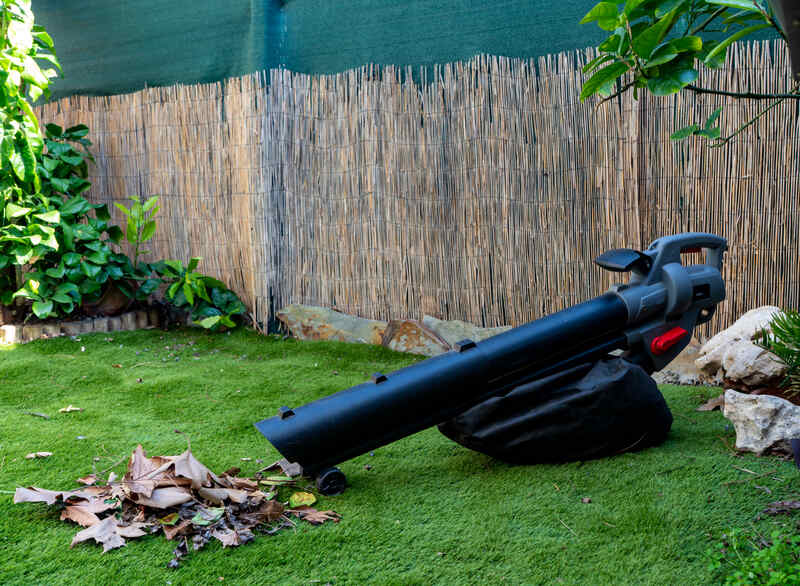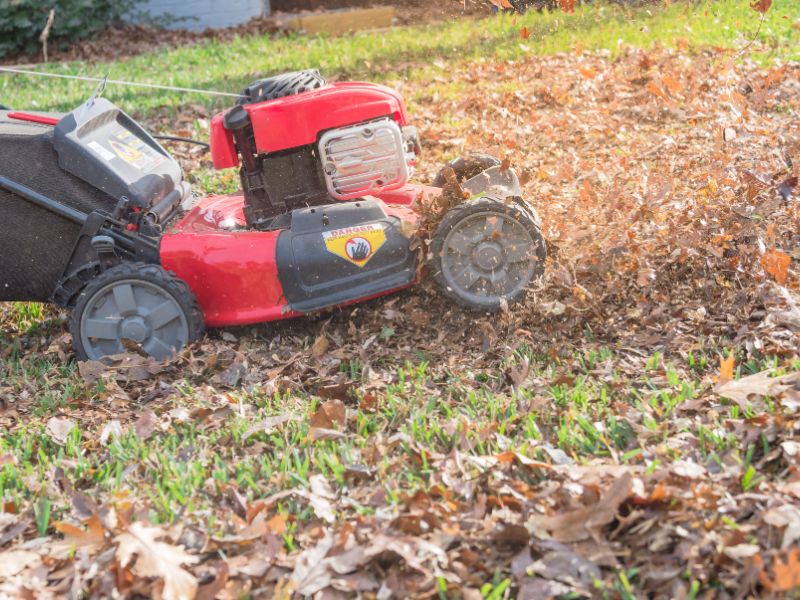
Whether you are cleaning up leaves for disposal or compost, you need to know what the best tools are to collect autumn leaves.
Leaves — especially wet leaves — left sitting on your lawn can leave your grass susceptible to lawn diseases and fungi. Dense piles of leaves suffocate grass, blocking the air and sun that it needs to thrive.
Essential Hand Tools for Precision Leaf Removal
If you’re looking for non-electric leaf removal tools, here are a few tools that will get rid of the leaves in your yard without all the ruckus that power tools emit.
Leaf Rakes
Best for: Small to medium yards
A rake is the most traditional leaf removal tool; it also happens to be a cheap, quiet leaf removal method. Select a lightweight rake with an ergonomic handle to reduce strain on your body as you work.
Rakes are also one of the best methods for collecting leaves in small yards.
“I recommend a leaf rake and a blower-vac for smaller yards, and either a mulching mower or a mower with a bagger for larger yards,” says Shawn Banks, county Extension director at North Carolina State University.
Pro Tip: “The best tip I can share is to keep the leaves removed as often as possible,” says Banks. “When the leaves pile up on the lawn, they can shade out the grass, which may kill it from lack of sun or lack of oxygen.”
| Pros of Leaf Rakes | Cons of Leaf Rakes |
| ✔ Cheap and cost-effective | ✗ Labor-intensive |
| ✔ No noise pollution | ✗ Time-consuming |
| Tired of a messy lawn? With LawnStarter’s leaf removal service, hire a pro to remove all the leaves and other debris from your yard. Last year, we completed nearly 12,000 leaf removal jobs at an average price of $158 per service and received an average rating of 4.3/5 from our customers. |
See Related:
- How to Rake Leaves
- 12 Types of Rakes: Uses and Tips
- 16 Tips for Cleaning Up Leaves in Your Yard
- 7 Best Leaf Rakes
Leaf Scoops

Best for: Small yards
Leaf scoops are like a handheld leaf shovel. They are used in pairs (one for each hand) and allow users to clamp a small pile of leaves and pick it up. A leaf scoop makes it easy to transport leaves to a nearby bag or disposal bin.
| Pros of Leaf Scoops | Cons of Leaf Scoops |
| ✔ Easy to transport leaves | ✗ Labor-intensive |
| ✔ Fun for kids | ✗ Requires frequent bending |
| ✗ Can move only small loads |
Leaf Grabber
Best for: Small to medium yards
A leaf grabber is similar to a leaf scoop, but it has two handles that give it a longer reach. A leaf grabber may be the better option if you want to avoid bending over frequently. Its reach allows you to securely collect leaves and bag them.
| Pros of Leaf Grabber | Cons of Leaf Grabber |
| ✔ Has a longer reach than leaf scoops | ✗ Labor-intensive |
Leaf Chutes and Funnels
Best for: Small to medium yards
Leaf chutes or funnels can be inserted into a paper bag to keep it open while you work. This means you won’t have to deal with the hassle of chilly fall winds blowing your bag over while you’re trying to wrangle it open to dump leaves inside.
| Pros of Leaf Chutes/Funnels | Cons of Leaf Chutes/Funnels |
| ✔ Makes leaf disposal easy for 1 person | ✗ Best for paper bags, not plastic bags |
Tarps

Best for: Medium or large yards
A tarp can be turned into a leaf collector, which makes it easy to transport large piles of leaves around your yard. The best way to use a tarp is to rake multiple smaller leaf piles around your yard, then you can drag the tarp around the yard and rake each pile onto the tarp.
It’s even easier if you buy a tarp that comes with handles, or attach tugger straps to your tarp. With a handle, it’s easy to transport a lot of leaves at once.
| Pros of Tarps | Cons of Tarps |
| ✔ Easy to transport lots of leaves | ✗ Limited carrying capacity |
Power Tools That Transform Leaf Cleanup
While more expensive than hand tools, power tools make leaf cleanup a breeze by speeding up the process. Here are some power tools you can use to help collect autumn leaves:
Leaf Blowers

Best for: Large yards
A leaf blower is the quickest way to gather leaves in a pile. Leaf blowers are also great for clearing leaves from tight or hard-to-reach spots where a rake can’t fit.
Depending on the model, leaf blowers have different power sources:
- Cordless/battery-powered
- Corded/electric leaf blowers
- Gas-powered leaf blowers
Leaf blowers work best on hard, flat surfaces such as driveways, porches, and sidewalks, and they are also great for grass. Once you’re done blowing them into piles, bag, shred, or rake them onto a tarp and drag to your compost pile.
| Pro Tip: “When using any gas-powered or electric equipment, wearing long pants, closed-toed shoes, eye protection, and gloves is recommended. In order to protect skin, consider wearing a hat and using sunscreen,” says Alison O’Connor, Extension professor of horticulture at Colorado State University. |
| Pros of Leaf Blowers | Cons of Leaf Blowers |
| ✔ Saves time | ✗ Noise pollution |
| ✔ Reaches tight spots | ✗ Expensive |
| ✔ No need for direct contact with leaves | ✗ Requires maintenance and repairs |
See Related:
- How Much Does a Leaf Blower Cost?
- How to Choose a Leaf Blower
- How to Use a Leaf Blower
- 8 Best Backpack Leaf Blowers
Leaf Vacuums

Best for: Small yards to large properties
Leaf vacuums are like a vacuum cleaner for your lawn: they use the power of suction to pick up leaves. Leaf vacuums have a long tube attachment, which sucks the leaves into a bag attached to the machine.
Although they are less popular, there are also walk-behind models that you push across your lawn like a lawn mower. If you own several acres of property, you might want to consider a tow-behind leaf vacuum for a riding lawn mower.
Like leaf blowers, leaf vacuums also have multiple power sources:
You can adjust the suction power of a leaf vacuum to avoid picking up mulch, gravel, or other loose bits of debris in your lawn or plant beds.
| Pros of Leaf Vacuums | Cons of Leaf Vacuums |
| ✔ Efficient cleanup | ✗ Sticks can clog the vacuum |
| ✔ Fast | ✗ Tow behind models are expensive |
| ✗ Require maintenance | |
| ✗ Gas-powered models cause noise pollution | |
| ✗ Low carrying capacity depending on type |
See Related: How to Remove Leaves from Mulch and Flower Beds
Mulching Mowers

Best for: All yards
Mulching mowers shred leaves into tiny pieces. Mulching leaves is the best way to improve the health of your grass. Instead of removing leaves, leave them on your lawn as fertilizer that provides your grass with nutrients and organic matter.
“The mulching mower chops up the leaves finely enough that they disappear into the lawn canopy and can be broken down by microbes that return the nutrients and organic matter in the leaves back to the soil,” says Banks.
“For the most part, homeowner equipment such as a rotary mower with a mulching blade, a rake, and possibly a leaf blower is all you need,” says O’Connor. “If you have lots of mature trees, it might be worth upgrading to larger equipment.”
If you don’t own a mulching mower, mow multiple passes with a regular lawn mower to chop the leaves into smaller pieces.
| Pro Tip: “For those with larger yards, I would recommend using a mower with a bagger for areas where there are a lot of leaves or a mulching mower in areas where there is a light covering of leaves,” says Banks. |
| Pros of Mulching Mowers | Cons of Mulching Mowers |
| ✔ Improves grass health | ✗ Expensive |
| ✔ Efficient cleanup | ✗ Require maintenance |
See Related:
Leaf Shredder

Best for: Small to large yards
A leaf shredder is a bowl-shaped machine that sits inside a disposal bin or is set up on a stand. Simply deposit leaves in the top, then the leaf shredder chops the leaves into small pieces.
Once the leaves are shredded, you can spread them over your lawn as fertilizer or use them to mulch trees, plant beds, and gardens. Even if you don’t use them for fertilizer, they’re easier to dispose of when the leaves are chopped up.
| Pros of Leaf Shredder | Cons of Leaf Shredder |
| ✔ Creates beneficial fertilizer | ✗ They can jam up |
Leaf Sweepers (Push and Tow-Behind)

Best for: Large properties
Rolling a leaf (aka lawn) sweeper over your lawn allows the machine to pick up leaves spread over your yard. This method works best on grass; a leaf sweeper will not perform as well on hard surfaces.
Push leaf sweepers have a shape that is reminiscent of a lawn mower, but with spinning brushes that catch leaves as they roll over your lawn. The collected leaves pile into a hopper attached to the machine. Since they are manually operated, they are quieter than power tools. Tow-behind leaf sweepers attach to riding mowers.
Once you’ve collected the leaves, dump them in your compost pile, collect on a tarp for easy bagging, or shred them for use around the lawn.
| Pros of Leaf Sweepers | Cons of Leaf Sweepers |
| ✔ Fast and efficient | ✗ Don’t mulch leaves |
| ✔ Not labor-intensive | |
| ✔ No noise pollution (push models) |
Hire a Pro for Leaf Removal
Your budget, time, and yard size are all key factors to consider when you decide what leaf removal tools are best for your yard. A rake and tarp are typically the best option for manual removal, but power tools provide speed and require less effort.
Or you can skip shopping for expensive leaf removal equipment and call a LawnStarter leaf removal pro to handle your lawn cleanup instead. This fall, take time to enjoy your weekends and “leaf” your lawn care chores to us.
See Related: How Much Does Leaf Removal Cost?
Sources:
Alison O’Connor, Extension professor of horticulture at Colorado State University Extension, Fort Collins, CO. Personal interview.
Shawn Banks, county Extension director and Extension agent at North Carolina State University, Morehead City, NC. Personal interview.
“Fall Leaves: Love ‘Em and Leave ‘Em.” By Margaret Montplaisir. Master Gardeners of Mercer County.
Main Image: Leaf rake. Photo Credit: Elenathewise / Adobe Stock